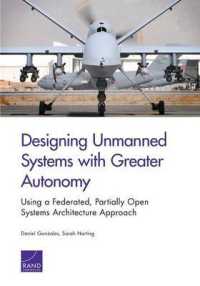- ホーム
- > 洋書
- > 英文書
- > Architecture
Full Description
The Routledge Handbook of Urban Design Practice brings together diverse voices in urban design, emphasizing the urgent need for innovative approaches to address shared challenges, offering actionable steps to empower practitioners, students, and academics in creating vibrant and sustainable cities.
The three-part structure of the Handbook guides the reader from foundations in urban design practice to an exploration of the great challenges confronting cities and people today closing with a consideration of the future of urban design. Part One: Urban Design Today offers a snapshot of historical influences, indirect design strategies, global perspectives, direct design strategies, and technological advances. Part Two: Urban Design Challenges includes perspectives on climate change and ecological design, public health, community change, social justice in urban design, economic resilience, and place quality. Part Three: Urban Design Tomorrow provokes deep thought on the state of the world and where urban design finds a place in making a better future. Each section of the book includes several chapters, which are preceded by introductions that situate and contextualize the writing to help the reader better comprehend the field. Each chapter defines a topic area, presents critical evaluation, and provides steps in practice that guide the reader toward a future that is more just, sustainable, and responsive. Following each chapter is a set of key summary messages that encapsulate central themes and suggestions for further reading that expand topical knowledge for the interested reader. The Handbook is comprised of over 100 new contributions on topics across urban design practice by a diverse array of authors from around the world. These voices represent the interdisciplinary nature of urban design: architects, planners, landscape architects, civil and transportation engineers, policymakers, and real estate developers. A glossary of built environment terms enriches urban design vocabulary, while cross-coding facilitates easy navigation to related materials for enhanced understanding. The Handbook serves as a go-to guide for urban designers seeking to expand their knowledge on special topics within and adjacent to their work, offering valuable insight into the methods and practices that are advancing urban design.
The primary audience consists of practitioners, students, and academics interested in the practice of urban design. In addition to built environment professionals, the book will also be of interest to those taking part in the urban conversation: city leaders, public officials, civic and non-government organizations (NGOs), and engaged urbanists. The Handbook addresses how technological advancements and the big challenges are reshaping urban spaces, making it an essential resource for those involved in the transformation and future of our cities.
Contents
1. Foundations of Practice: Introduction 1.1 Urban Design Education & Training 1.2 Organizational Contexts for Urban Designers: Current Roles and Future Trajectories 1.3 The Many Modes of Collaboration: Collaboration Throughout the Urban Design Process 1.4 How Urban Designers Can Borrow Ideas from the Advocacy Professionals to Master the Political Lens of Our Work 1.5 Engagement & Inclusion in Urban Design 1.6 Urban Design Products & Programming 1.7 Site Planning 1.8 Schematic Design and Design Process 2. Urban Design Planning & Process: Introduction 2.1 In Defense of Design Policy: Strategies for Practice 2.2 Towards a More Inclusive and Reflective Urban Design Practice: Five Principles for Beginning a Project 2.3 Neighborhood Planning and Urban Design 2.4 Form-based Codes 2.5 Design Charrettes 2.6 Design Review & Design Guidelines 2.7 Designing with Dignity: Piloting Bold Ideas to Advance the Human Experience 3. Global Cities and Urban Design: Introduction 3.1 Informal and Formal Urbanism in Urban Design 3.2 Cheaper and Safer to Build a Community than a House: how urban design can address unsettledness 3.3 The Dream of Brazilian Urban Reform 3.4 Snapshot of Urban Design Practice: Chile 3.5 Snapshot of Urban Design Practice: Columbia 3.6 Snapshot of Urban Design Practice: Ghana 3.7 Snapshot of Urban Design Practice: The Netherlands 3.8 Snapshot of Urban Design Practice: Spain 3.9 Snapshot of Urban Design Practice: Iraq 3.10 Snapshot of Urban Design Practice: India 3.11 Snapshot of Urban Design Practice: China 3.12 Snapshot of Urban Design Practice: Korea 4. Shaping the City: Introduction 4.1 Structuring the City 4.2 Development Types & Practices (Uses, Program, Components) 4.3 Rationales for Dominant Building Types and Practices 4.4 Vertical Urbanization, Placemaking and High-Rise Buildings 4.5 Human Scale High-Density Urban Design 4.6 Transit Types & Practices 4.7 Beyond Bump-Outs - a brief overview of contemporary pedestrian and public-space oriented street designs 4.8 Calming Traffic and Sharing Streets 4.9 Micro-mobility Types & Practices in Urban Design 4.10 Walkable Urbanism 4.11 Strategizing Streets and Streetscapes 4.12 Landscape Types & Practices 4.13 Design Details with Purpose 5. Technology & Innovation in Urban Design Practice: Introduction 5.1 The Uses of Digital Knowledge in Urban Design 5.2 Social Life & Social Space in the City 5.3 Digital Civics & Citizenship in Urban Design 5.4 Urban Data Visualization 5.5 Airspace and Urban Design, but don't call them "flying cars" 6. Climate Change and Urban Design: Introduction 6.1 Net Zero Cities & Urban Design 6.2 Sea Level Rise & Urban Design 6.3 Remaking Urban Design for Climate Resilience 6.4 Strategies in Urban Adaptation 6.5 Biophilic Cities: A New Framework for Urban Design and Planning 6.6 Planning for Successful Green Infrastructure 6.7 Urban Forest Strategies for a Changing Climate 6.8 Environmental Sustainability and Urban Design 7. Public Health and Urban Design: Introduction 7.1 Wellness, Identity, and Urban Design 7.2 Spatial Cognition, Mental Health, and Wellbeing 7.3 Pandemic Response & Urban Design 7.4 Urban Design and Healthy Suburbs 7.5 Urban Design and Safety 7.6 Urban Design: Making Space for Play 7.7 Food Systems and Access in Urban Design 7.8 Trauma-informed Design 8. Community Flux and Urban Design: Introduction 8.1 Urban Design for Complete Communities 8.2 Urban Design for Multiple Public Interests 8.3 Displacement Resilience Through Equitable Development 8.4 Gentrification & Urban Design 8.5 Urban Planning for Reparations: Transforming Spaces, Restoring Equity 8.6 Zoning Reform 8.7 Urban Design as if Black Lives Matter 8.8 LGBTQ Inclusive Urban Design 8.9 Social Sustainability in Urban Design Practice 9. Justice and Urban Design: Introduction 9.1 Redressing Past Urban Design Injustices 9.2 Radical Transformation: The Right to the City in Urban Design 9.3 Ensuring Voice & Belonging in Urban Design 9.4 Cross-Cultural Skills & Cultural Competency in Urban Design 9.5 Toward Interactive Justice in Urban Design: The Role of Intercultural Communication 9.6 A Practitioner's Guide to Catalyzing Commercial Corridor Investment 9.7 Environmental Justice in Urban Design 10. Economic Resilience and Urban Design: Introduction 10.1 Urban Design in Times of Boom & Decline 10.2 Design for Economic Diversification 10.3 Urban Design for Economic Vitality 10.4 Urban Design & Equitable Economic Development 10.5 Urban Design, Social Equity, and Urban Land Value 10.6 Affordable Housing Design: Typologies and Considerations 10.7 Adaptive Reuse as Urban Design: Finding Economic Resilience in Old Buildings 10.8 Urban Design and the Creative City 10.9 A Cultural Oriented Approach: Affirming Community Roles in the Urban Re-Design Process 10.10 The Informal Economy and Urban Design 10.11 Economic Sustainability in Urban Design 11. Placemaking and Place Quality: Introduction 11.1 Designing the Livable City 11.2 Placemaking, Caring and Keeping 11.3 Cultivating a Sense of Belonging through Place Stewardship 11.4 Narrative Landscapes and Urban Design 11.5 Putting the Public and the Art Into Public Art 11.6 Catalytic Public Realm Investment 11.7 Materiality in Placemaking: The role of paving in the image of the city 11.8 Ecological Placemaking 11.9 Landing in a Region: A Geographic Approach to Urban Design 11.10 Urban Design & Global Tourism 12. Urban Design Practice into the Future: Introduction 12.1 Projecting the Future City 12.2 Toward an Ethical Future 12.3 Designing the Regenerative City of the Future 12.4 The Future of Public Space 12.5 Exigency of Urban Design in Our Collective Future








